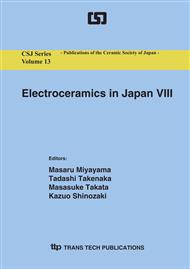p.193
p.197
p.201
p.205
p.211
p.215
p.219
p.223
p.227
Control of Nanoscale Morphology of Oxide Crystals Using Aqueous Solution Systems
Abstract:
We successfully controlled nanoscale morphology of ZnO, SnO2 and TiO2 grown in aqueous solution systems. Nanograins, nanorods and nanosheets of the metal oxides were obtained with variation of the preparation conditions including the concentration of the precursor reagents, pH and addition of various organic molecules and inorganic ions. The morphological evolution of wurtzite-type ZnO crystals from hexagonal nanorods to nanoplates and nanosheets was induced by the coexistence of phosphate anions and specific carboxylates. An increase in the concentration of SnF2 and pH changed the nanoscale morphology of crystalline SnO2 from grains into rods, flakes and sheets. Nanorods of anatase and rutile were deposited in the solutions of TiF4 and TiOSO4 by controlling pH and addition of urea. Nanosheets of titanate were prepared with ammonia anions in agar gel containing TiF4 and easily transformed into nanosheets of anatase.
Info:
Periodical:
Pages:
211-214
Citation:
Online since:
January 2006
Authors:
Keywords:
Price:
Сopyright:
© 2006 Trans Tech Publications Ltd. All Rights Reserved
Share:
Citation:


